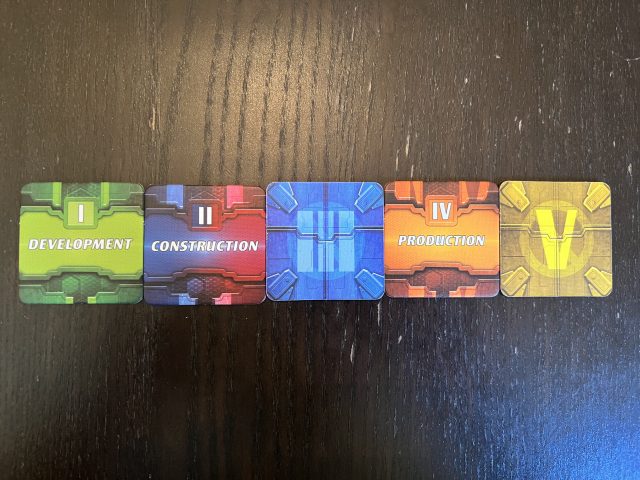Race for the red planet
Ares Expedition plays a bit like a mashup of Terraforming Mars and the 2007 card game Race for the Galaxy. That’s not a slight—it’s praise. Race for the Galaxy is one of the most beloved designer card games of all time, and its mechanics have been borrowed to produce scores of excellent titles. (Lest the pedants come for my head, yes, RftG reimplements concepts of earlier games, most notably Puerto Rico.) Of particular note here are the game’s central mechanics—what we in the biz refer to as “simultaneous action selection” and “variable phase order.”
The game has five “phases,” but not every phase will be triggered each round. Only the phases that players select will be active in any given round. Each player has five numbered phase cards, and at the beginning of each round, everyone selects one to play. The chosen phases will be active for everyone, not just the players who selected them. The phases trigger one after the other in ascending order.

Aaron Zimmerman
Each round, players will choose one phase card to play. Only the phases that are chosen by players will be active that round.
Aaron Zimmerman

Aaron Zimmerman
In this example, the “development,” “construction,” and “production” phases will be triggered. You can use these handy tokens to remind everyone which phases are active.
Aaron Zimmerman
Each round, players will choose one phase card to play. Only the phases that are chosen by players will be active that round.
Aaron Zimmerman
In this example, the “development,” “construction,” and “production” phases will be triggered. You can use these handy tokens to remind everyone which phases are active.
Aaron Zimmerman
The main thrust of the game is to generate resources—money, heat, and plants—and then use those resources to do terraforming actions. Cards you play remain in your player area and will trigger during specific phases.
Say I want to play the “development” phase card, which allows me to “purchase” and play a green card from my hand; the card stays in my area and generates resources during the production phase. All of my opponents would also get to play a green card, provided they have enough resources to pay for it. Of course, someone will need to play the “production” phase card before anyone can reap those rewards.
But since I’ve been paying attention, I’ve noticed that one player is mostly out of resources. I could make an educated guess that this player might want to play the “production” card. The production phase comes after the development phase, so if I’m right about my hunch, I can play a resource-generating card and generate resources from it in the same round. Efficient!

Aaron Zimmerman
The player board tracks all your resource generation, and the plastic cubes represent the resources you currently have (gold=10, silver=5, bronze=1).
Aaron Zimmerman

Aaron Zimmerman
Cards you play stay in your player area and trigger during the various phases of the game. The cards are color-coded to help keep things simple.
Aaron Zimmerman
The player board tracks all your resource generation, and the plastic cubes represent the resources you currently have (gold=10, silver=5, bronze=1).
Aaron Zimmerman
Cards you play stay in your player area and trigger during the various phases of the game. The cards are color-coded to help keep things simple.
Aaron Zimmerman
In this way, players are always trying to piggyback off of other players’ chosen phases, and the key to success is intuiting which phases your opponents are going to select. You generally don’t want to play a phase you know someone else will play, though you do get a bonus for the phase you’ve played. The “production” phase, for example, lets everyone draw two cards from the deck and keep one. But anyone who chose that phase gets to draw five cards and keep two. In a clever twist on this now-familiar mechanic, Ares Expedition disallows playing the same phase card twice, which adds another wrinkle to consider as you’re trying to read your opponents.
Everyone performs their actions simultaneously—during the production phase, for instance, every player can take their resources at the same time, keeping the game moving at a nice clip. You’re always doing something, so you’re always engaged.
Make it rain
Terraforming Mars: Ares Expedition
As in any “engine-building” game, the fun is in starting with very little and building your way up to explosive turns in the later rounds. A production phase at the beginning of the game will net you a pittance of resources; at the end of the game, that same trigger will make it rain. And all because of the way you built your little machine. Generating an avalanche of resources, buying cards for free, setting off chain-reaction combos—you did that! You made it happen! It’s very satisfying.
Whoever has the most points at the end of the game wins. Most of the points come from your “terraforming rating,” which ticks up when you raise any of the global parameters, but you can also get points from cards and other actions. It’s a card game, so your strategy will depend to some extent on the cards you draw, but there are enough ways to boost your card draw and enough skill required to piece together the parts of your engine that randomness will not determine the winner.

Aaron Zimmerman
The “Collector’s Edition” includes these (pretty much essential) dual-layer player boards, which keep your pieces in place. Skip the Target version if you can.
Aaron Zimmerman
You also get these handy resources trays.
Aaron Zimmerman
You also get these handy resources trays.
Aaron Zimmerman
The cover art for the Collectors Edition is full-bleed; the Target edition frames its title in a red box.
Aaron Zimmerman
Perhaps best of all, Ares Expedition fixes the atrocious production values of the original board game. The art is professional and uniform, and the pieces all feel up to modern board game standards. The cards are easy to read, and their mechanics feel true to their themes.
There are actually two versions of the game, a mass-market Target exclusive ($40 MSRP) and a “Collector’s Edition” ($60 MSRP) that you can find on Amazon and some games stores. If you can get the Collector’s Edition for a decent price (it’s $50 on Amazon as of this writing), we highly recommend it over the Target version because the player boards in the Collector’s Edition are dual-layer, which helps keep your pieces firmly in place. It’s annoying to have to pay a premium for such an essential feature, but that’s the situation.














